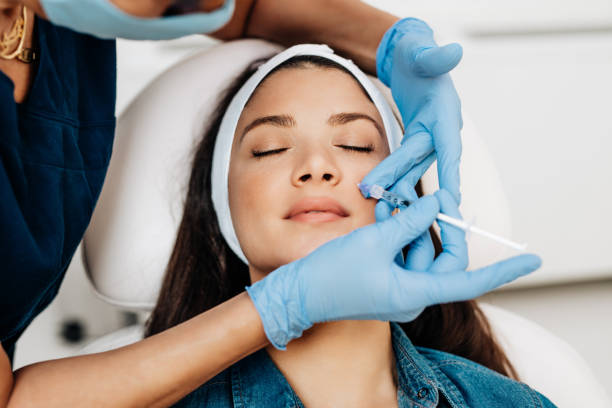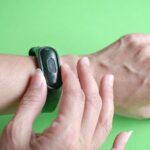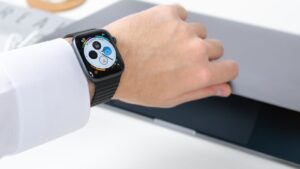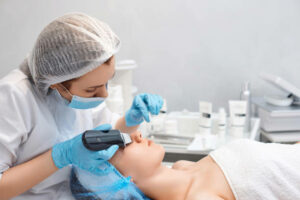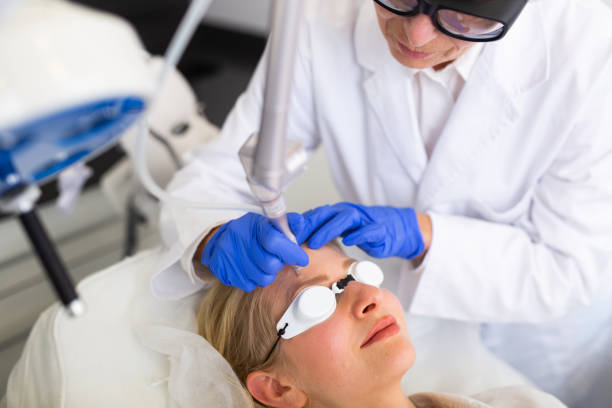
Young woman getting laser facial treatment from experienced elderly female cosmetologist in aesthetic medicine office
Dermabrasion and microdermabrasion are both skincare techniques that exfoliate the top layers of skin to reveal a smoother, more youthful complexion. While both procedures can offer numerous benefits, they differ in terms of their intensity, target area, and recovery time.
Dermabrasion involves the use of a high-speed rotating brush or wheel to remove the outermost layers of skin. This treatment is typically more aggressive and used to address deeper skin imperfections like acne scars, wrinkles, and sun damage. The recovery time for dermabrasion is longer than microdermabrasion, taking several days to a week for the skin to fully heal. On the other hand, microdermabrasion uses tiny crystals or diamond-tipped wands to buff away the outermost layer of dead skin cells. This treatment is less intensive and used primarily to improve the overall texture and appearance of the skin. The recovery time for microdermabrasion is minimal, and most people can return to their daily activities immediately after the procedure.
Ultimately, the choice between microdermabrasion vs. dermabrasion comes down to your individual skincare needs and goals. While microdermabrasion may be suitable for regular upkeep and maintenance, dermabrasion may be necessary for more targeted and intensive treatments.
What is Dermabrasion and How Does it Work?
Dermabrasion is a type of cosmetic procedure that involves removing the outer layers of skin with special equipment such as an abrasive wheel. This is different from microdermabrasion which uses tiny crystals to sand away the top layers of the skin. Dermabrasion can be used to improve the appearance of acne scars, wrinkles, and sun-damaged skin. The procedure can also remove tattoos and other unwanted pigments. Let’s go over how dermabrasion works and the potential risks and benefits of the procedure.
Definition of Dermabrasion and Microdermabrasion
Dermabrasion and microdermabrasion are two cosmetic procedures used to improve the texture and appearance of the skin. Dermabrasion is a more invasive treatment that involves removing the top layer of skin using a high-speed rotating brush. Microdermabrasion is a gentler procedure that uses a spray of fine crystals or a tip with a diamond head to exfoliate the skin’s outer layer.
Here are the key differences between Dermabrasion and Microdermabrasion:
- Dermabrasion: – Requires anesthesia – Can treat deeper wrinkles, scars, and sun damage – One treatment is enough to see results – Recovery time is longer, up to three weeks
- Microdermabrasion: – Does not require anesthesia – Only treats superficial skin issues like fine lines, age spots, and dryness – Several treatments may be required to see results – Recovery time is minimal, only a few hours
Both procedures have their unique benefits and risks, and it’s essential to consult a dermatologist before deciding which treatment is best suited for you.
How Dermabrasion and Microdermabrasion Works to Refresh the Skin
Dermabrasion and microdermabrasion are two techniques used to refresh the skin, but they differ in intensity, the target skin depth, and post-treatment care requirements. Dermabrasion targets the deeper layers of the skin, while microdermabrasion is a superficial exfoliation.
Here’s how they work:
- Dermabrasion: A dermatologist or aesthetician uses a high-speed rotating tool to remove the top layer of skin, including scars, wrinkles, and pigmentation issues. This technique is suited for people seeking significant skin rejuvenation and ideal for treating acne scars or deeper wrinkles. After the procedure, the skin may be raw, swollen or bruised, and take up to several weeks to heal.
- Microdermabrasion: A handheld device streamlines microscopic crystals to exfoliate the outermost layer of skin, and then uses suction to remove the dead skin cells. This technique is best for those seeking a non-invasive way to improve skin texture, fine lines and age spots. After the procedure, the skin may appear slightly red and feel slightly tender, but no downtime or healing is required.
Both Dermabrasion and Microdermabrasion are effective procedures, and the choice will depend on the patient’s skin goals and level of skin repair required.
Benefits of Dermabrasion and Microdermabrasion
Dermabrasion and microdermabrasion are popular skin resurfacing treatments that can improve a wide range of skin concerns, from acne scars to wrinkles. Dermabrasion involves using a high-speed rotating brush to remove the top layers of skin, while microdermabrasion involves using a fine abrasive material to gently exfoliate the skin.
Here are some of the benefits of each treatment:
Dermabrasion:
- Can treat deeper skin imperfections, such as deep scars and wrinkles.
- Provides more dramatic results.
- Good for people with more severe skin damage.
Microdermabrasion:
- Gentle procedure with minimal discomfort and no downtime.
- Provides a more superficial exfoliation, making it perfect for people with more sensitive skin.
- Helps to improve skin texture, tone, and overall appearance.
Whether you choose dermabrasion or microdermabrasion depends on the severity of the skin concern you want to address. It is important to consult with a skincare professional to determine which option best suits your needs.

Preparing for Dermabrasion; What to Expect
If you are considering dermabrasion, you should know that it is a procedure that can help to improve the texture and appearance of the skin. Before undergoing this procedure, it is important to understand what to expect and to prepare for the treatment. In this section, we will cover the various aspects of dermabrasion to help you prepare for the procedure. We will also compare the differences between dermabrasion and microdermabrasion in order to get a better understanding of the two.
Who is Suitable for Dermabrasion and Microdermabrasion
Dermabrasion and microdermabrasion treatments are generally suitable for individuals who want to improve the appearance of their skin and reduce fine lines, wrinkles, acne scarring, and hyperpigmentation. Dermabrasion is suitable for people with fair skin and those who do not have active acne, while microdermabrasion is safe for all skin types and colors.
Before undergoing dermabrasion or microdermabrasion treatment, it is essential to prepare your skin by avoiding sun exposure, waxing, and using harsh beauty products. During the procedures, patients can expect their skin to become mildly red, swollen, and sensitive to the touch. Microdermabrasion is a gentler treatment that uses fine crystals or a diamond-tip wand to exfoliate the skin’s upper layer. In contrast, dermabrasion is a more intensive procedure that uses a medical-grade wire brush or diamond wheel to resurface the skin’s deeper layer.
Consult with a qualified dermatologist or aesthetician to determine which treatment is best for your skin type and desired outcome.
What To Do Before Your Dermabrasion
Before going for a dermabrasion treatment, there are a few things you can do to prepare your skin and make sure you have a successful procedure.
Here’s what to do before your dermabrasion:
- Consult your dermatologist to determine the right form of dermabrasion for your skin concerns – microdermabrasion or dermabrasion.
- Avoid excessive sun exposure and tanning beds for two weeks prior to the procedure.
- Stop using exfoliating creams or scrubs, as well as any harsh skincare products, for two weeks prior to the treatment.
- Do not undergo any other facial treatments or procedures such as chemical peels, waxing or laser treatments for at least two weeks prior to dermabrasion.
- Keep your skin moisturized with gentle and non-abrasive skincare products to make it more receptive to the treatment.
Inform your dermatologist if you have any history of cold sores, acne breakouts or facial scarring. Knowing what to expect and how to prepare for your dermabrasion treatment will help you achieve the best possible outcome.
Pain Management Options
Dermabrasion is a popular cosmetic procedure used to improve the appearance of the skin. Proper pain management is crucial to ensuring a comfortable and successful experience during and after the procedure.
There are several pain management options available for dermabrasion, including:
- Topical Anesthetics: These are applied to the skin before the procedure to numb the area and reduce pain. They come in different forms such as creams, gels, or patches, and need to be applied at least an hour before the procedure.
- Local Anesthesia: A type of anesthesia injected directly into the skin or applied to the surrounding area to numb the skin and reduce pain. Local anesthesia is usually used for deep dermabrasion procedures.
- Sedation: This option involves taking medication to relax and calm the patient, making it easier to tolerate the procedure. Sedation is generally used for deeper dermabrasion procedures or longer duration treatments.
Overall, the choice of pain management option will depend on the type of dermabrasion procedure, the amount of pain anticipated, and the patient’s overall health.
Pro Tip: Before undergoing dermabrasion, it is important to discuss with your doctor which pain management option is best for you.
Microdermabrasion vs Dermabrasion
If you’re thinking of getting a facial treatment, you may want to consider dermaplaning, microdermabrasion, or dermabrasion. All three treatments can be effective at improving the look of your skin and can help reduce the appearance of blemishes and scars. However, it is important to understand the differences between the three treatments so that you can make an informed decision about which one is best for you. Let’s take a look at the differences between dermaplaning, microdermabrasion, and dermabrasion.
How Dermaplaning Works
Dermaplaning is a cosmetic procedure that exfoliates the top layer of the skin to remove dead skin cells, peach fuzz, and other debris. Unlike microdermabrasion and dermabrasion, which use abrasive particles and tools to resurface the skin, dermaplaning employs a surgical scalpel to achieve a smooth and bright complexion.
Here’s how it works: A licensed aesthetician will cleanse and dry your face before using a scalpel at a 45-degree angle to shave off the dead skin cells and vellus hair on your face.
The process is painless and non-invasive and lasts around 30 minutes. You will notice immediate results with no downtime, as dermaplaning stimulates cell turnover and collagen production and enhances the absorption of skincare products. However, it is not suitable for those with active acne, ultra-sensitive skin, or bleeding disorders. When it comes to comparing dermaplaning vs microdermabrasion vs dermabrasion, dermaplaning is least invasive and ideal for those with smooth and sensitive skin.
How Microdermabrasion Works
Microdermabrasion is a non-invasive cosmetic procedure that uses tiny crystals or a diamond-tipped wand to remove dead skin cells from the surface layer of the skin. This encourages the growth of new skin cells and collagen, resulting in smoother, brighter, and more youthful-looking skin.
Dermaplaning and Dermabrasion are two other skin resurfacing procedures that use different techniques to remove layers of the skin to reveal newer, healthier skin cells. Dermaplaning involves using a surgical scalpel to scrape off the top layer of dead skin cells and fine hairs. Dermabrasion, on the other hand, involves using a high-speed rotating brush or diamond wheel to remove the top layer of skin.
While these procedures have similar goals, microdermabrasion is a less invasive option that is suitable for most skin types and requires no downtime. Dermaplaning and Dermabrasion are more intensive treatments that may be better suited for individuals with specific skin concerns and require longer recovery times.
Pro tip: Consult with a skincare professional to determine which of these treatments is best for your skin type and desired results.

Comparison Between the Three Types of Skin Exfoliation Techniques
When it comes to skin exfoliation, there are three main techniques: dermaplaning, microdermabrasion, and dermabrasion. While all three methods aim to remove dead skin cells and improve skin texture and appearance, they differ in their approach and effectiveness.
- Dermaplaning: This technique involves using a surgical scalpel to shave off the top layer of dead skin cells and fine facial hair. Dermaplaning is a safe and painless procedure that leaves the skin smooth and glowing. However, it has minimal impact on deeper skin issues like acne scars and wrinkles.
- Microdermabrasion: In this procedure, tiny crystals are sprayed onto the skin to remove dead cells and stimulate collagen production. Microdermabrasion is best for treating superficial skin issues like uneven skin tone, fine lines, and mild acne scars. It’s a quick procedure that requires no recovery time.
- Dermabrasion: Unlike the other two methods, dermabrasion is a more invasive procedure that requires local anesthesia. It involves using a high-speed rotating brush to remove several layers of skin to treat deeper scars, wrinkles, and sun damage. Dermabrasion is effective but requires a longer recovery time and is not suitable for all skin types.
Each method has its benefits and limitations, and choosing the right one depends on your skin type, concerns, and desired outcome.
Risks and Complications of Dermabrasion and Microdermabrasion
Both dermabrasion and microdermabrasion are treatments that involve removing the top layer of skin to reveal the smoother and clearer skin beneath it. Dermabrasion involves using a tool that is like an electric sander to remove the top layer of skin and microdermabrasion involves using a device to spray a fine jet of abrasive crystals on the skin’s surface. While both of these treatments can produce great results, they do have risks and possible complications. Let’s look into these in more detail.
Potential Complications of Dermabrasion and Microdermabrasion
Dermabrasion and microdermabrasion are cosmetic procedures that use different techniques to exfoliate the skin and reduce the appearance of scars, wrinkles, and other blemishes. Although these procedures are generally safe, there are some potential risks and complications to be aware of.
Dermabrasion is a more invasive procedure that requires anesthesia and has a longer recovery time than microdermabrasion. The risks associated with dermabrasion include infection, scarring, changes in skin pigmentation, and prolonged redness. Microdermabrasion is a gentler and less invasive procedure that does not require anesthesia and has a shorter recovery time. The risks associated with microdermabrasion include skin irritation, sun sensitivity, and risk of developing broken capillaries on the face.
To minimize the risk of complications, it is essential to choose an experienced and licensed skincare professional to perform these procedures and to follow their aftercare instructions closely.
Pro tip – Before deciding on any cosmetic procedure, it’s important to do your research and choose a licensed professional with a good reputation to perform the treatment.
Post-Treatment Care After Dermabrasion and Microdermabrasion
Dermabrasion and microdermabrasion are popular skin resurfacing treatments. After undergoing these treatments, it’s essential to take proper care of your skin to ensure optimal healing and avoid any risks or complications.
Here are a few tips for post-treatment care after dermabrasion and microdermabrasion:
- Keep your skin moisturized to prevent dryness, itching, and flaking. Apply a moisturizer or gentle cream recommended by your dermatologist.
- Avoid UV exposure as much as possible, and apply sunscreen with at least SPF 30 before going outside to prevent skin damage and pigmentation.
- Avoid exfoliating or irritating your skin for a few weeks post-treatment, as your skin will be sensitive and prone to inflammation.
- Don’t use any harsh products, such as alcohol-based toners and astringents or acne treatments, during the healing process.
- Keep your follow-up appointment with your dermatologist to ensure proper healing progress and avoid any complications.
Pro-tip: Avoid touching or scratching your treated skin to minimize the risk of infection and scarring.
Choosing an Experienced Practitioner
When it comes to microdermabrasion or dermabrasion, it is important to choose an experienced practitioner to help you achieve your desired results. This is due to the fact that both of these procedures are cosmetic in nature and require a certain level of precision and skill in order to be done safely and effectively. Therefore, it is essential to select a practitioner who is knowledgeable and certified in their field.
What to Consider When Choosing a Dermabrasion and Microdermabrasion Practitioner
When choosing a practitioner for dermabrasion or microdermabrasion, there are several important factors to consider to ensure that you receive a safe and effective treatment.
- Experience: Look for a practitioner with years of experience performing both dermabrasion and microdermabrasion, who specializes in skin resurfacing treatments. This ensures that they have the necessary skills and knowledge to perform your treatment correctly.
- Credentials: Ensure that the practitioner is licensed and certified to perform dermabrasion or microdermabrasion. Ask to see their credentials and to view before-and-after photos of their previous patients.
- Consultation: Choose a practitioner who offers a thorough consultation before your treatment, during which they will discuss your skin concerns, medical history, and expected results. This will ensure that your treatment is personalized to your needs.
- Equipment: Make sure that the practitioner uses state-of-the-art equipment for both dermabrasion and microdermabrasion, as this will ensure a safe and effective treatment.
By considering these factors, you can choose a practitioner who will provide you with a safe and effective dermabrasion or microdermabrasion treatment that achieves your desired results.
Precautions to Take When Selecting a Dermabrasion and Microdermabrasion Provider
Choosing the right dermabrasion or microdermabrasion provider requires some precautions to avoid complications and unsatisfactory results.
Here are some essential things to consider:
- Experience: Always choose a practitioner who is experienced in performing dermabrasion or microdermabrasion. Ask for their qualifications, training, and certification.
- Equipment: Ensure the practitioner uses the latest equipment and follows sterilization procedures to prevent infections.
- Consultation: Schedule a consultation to discuss your skin concerns, expectations, and any questions you have about the procedure. A reputable provider should inform you of potential risks and benefits and help you make an informed decision.
- Cost: Don’t be swayed by low prices; always prioritize quality and safety. Keep in mind that multiple sessions may be required for optimal results.
Microdermabrasion Vs. Dermabrasion: Microdermabrasion is a gentler and less invasive procedure, making it more suitable for individuals with mild or sensitive skin issues. On the other hand, dermabrasion is more intense and penetrates deeper layers of the skin, treating more severe skin concerns.
By taking precautions and considering these factors, you can select a qualified practitioner who will help you achieve your desired outcome safely and effectively.
How to Verify the Practitioner’s Qualifications and Expertise
When choosing a practitioner for dermabrasion treatment, it’s important to verify their qualifications and expertise to ensure a safe and effective procedure. Here’s how to do it:
- Check their credentials: Look for a practitioner who is licensed and certified by a reputable medical or cosmetic board in your country.
- Review their experience: Find out how many dermabrasion treatments the practitioner has performed and how long they have been in practice.
- Ask for before-and-after photos: Request to see pictures of previous patients who have undergone dermabrasion treatment with the practitioner you are considering.
- Read reviews and testimonials: Look for online reviews or ask for references from previous patients to gain insight into their experiences.
Remember, dermabrasion is an invasive procedure that requires skill and experience to perform correctly. By taking the time to verify your practitioner’s qualifications and expertise, you can ensure a successful outcome.
Pro-tip: Before scheduling a consultation for dermabrasion treatment, research different types, such as microdermabrasion vs dermabrasion, to understand the differences in treatment methods, results, and potential risks.

